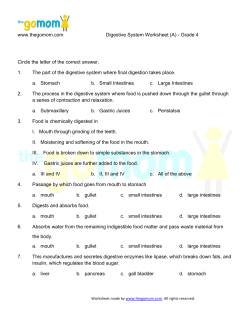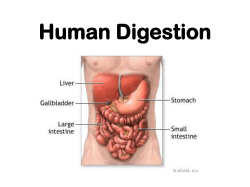
Digestive System Grades 9 to 12 • Human Body Series
Grades 9 to 12 • Human Body Series Digestive System KidsHealth.org/classroom Teacher’s Guide Your students probably don’t know as much as they could about how food powers their bodies. The more they know about their digestive systems, the better prepared they will be to make good decisions about nutrition and exercise, as well as treating minor digestive problems like indigestion. This guide includes: • Standards • Related Links • Discussion Questions • Activities for Students Related KidsHealth Links Articles for Teens: Digestive System • Reproducible Materials KidsHealth.org/teen/your_body/body_basics/digestive_system.html Mouth and Teeth KidsHealth.org/teen/your_body/body_basics/mouth_teeth.html Standards Metabolism This guide correlates with the following National Health Education Standards: Students will: • Comprehend concepts related to health promotion and disease prevention to enhance health. • Analyze the influence of family, peers, culture, media, technology, and other factors on health behaviors. • Demonstrate the ability to access valid information and products and services to enhance health. • Demonstrate the ability to use interpersonal communication skills to enhance health and avoid or reduce health risks. • Demonstrate the ability to use decision-making skills to enhance health. • Demonstrate the ability to use goal-setting skills to enhance health. • Demonstrate the ability to practice health-enhancing behaviors and avoid or reduce health risks. • Demonstrate the ability to advocate for personal, family, and community health. KidsHealth.org/teen/nutrition/general/metabolism.html Why Exercise Is Wise KidsHealth.org/teen/food_fitness/exercise/exercise_wise.html The Food Guide Pyramid KidsHealth.org/teen/nutrition/general/pyramid.html Gastrointestinal Infections and Diarrhea KidsHealth.org/teen/infections/intestinal/diarrhea.html Indigestion KidsHealth.org/teen/diseases_conditions/digestive/indigestion.html Discussion Questions Note: The following questions are written in language appropriate for sharing with your students. 1. What does it mean for the digestive system to “break down” food? How does this happen in the mouth, stomach, and intestines? How does the food move from the digestive system into the rest of the body? 2. In addition to the structural parts of the digestive system, various chemicals are also at work. Discuss the roles they play in digestion. 3. How do healthful foods help digestion? How about exercise? 4. There are several very common problems with the digestive system, like indigestion and diarrhea. How do they happen? Your state’s school health policies: nasbe.org/HealthySchools/States/ State_Policy.asp © 2006 The Nemours Foundation/KidsHealth. Reproduction permitted for individual classroom use. Grades 9 to 12 • Human Body Series Digestive System Activities for Students Note: The following activities are written in language appropriate for sharing with your students. What’s the Problem? Objectives: Students will: • Learn about various diseases and problems of the digestive system • Understand how these diseases affect the body’s ability to get the nutrition it needs Materials: • • Pen and paper Computer with Internet access or the school library Class Time: 30 minutes Activity: So you’ve learned how the digestive system delivers nutrients to the body. But what if something goes wrong? From common issues like diarrhea to bigger trouble like celiac disease, there are many different digestive health problems. Some, like constipation, originate in the digestive system, whereas others don’t but still cause digestive symptoms. For example, bulimia is a mental health problem, but people with bulimia can often experience stomach damage, tooth decay, and swollen salivary glands as a result of constant vomiting. List the following digestive problems on a separate sheet of paper. Give a one-sentence description for each one, and then write another sentence or two about how the problem affects the digestive system’s ability to do its job. • • • • • • • • • • Alcoholism Bulimia Celiac Disease Constipation Gastroesophageal Reflux Disease (GERD) Indigestion Inflammatory Bowel Disease Irritable Bowel Syndrome Lactose Intolerance Ulcers Extensions: 1. For each problem, write a sentence or two about how it can be prevented or treated. 2. Write a paragraph about what you think it’s like for a person your age to have celiac disease. © 2006 The Nemours Foundation/KidsHealth. Reproduction permitted for individual classroom use. Grades 9 to 12 • Human Body Series Digestive System Lunch to Go Objectives: Students will: • Track the foods they eat as they work their way toward the bloodstream • Describe how the body breaks down these foods Materials: • • • Pen Lunch to Go handout (available at: KidsHealth.org/classroom/9to12/body/systems/digestive_handout1.pdf) Computer with Internet access or the school library Class Time: 30 minutes Activity: Food gives you energy, right? When you eat a sandwich, for example, your digestive system breaks it down into the fuel your body needs to build tissue and keep your organs functioning properly. How does it do it? It’s not sending little chunks of sandwich to your tissues, so what’s happening? On the handout sheet, describe what happens to food at each stop along the digestive system. At the same time, other parts of the body are playing their roles. Fill in a description of each of their functions. Extensions: On the back of the handout, answer these questions: 1. What can you do to help food move through your digestive system? What foods help? What roles do water and exercise play in aiding digestion? 2. What happens when a person gets diarrhea? What should people do if they have this problem? Reproducible Materials Handout: Lunch to Go KidsHealth.org/classroom/9to12/body/systems/digestive_handout1.pdf Quiz: Digestive System KidsHealth.org/classroom/9to12/body/systems/digestive_quiz.pdf Answer Key: Digestive System KidsHealth.org/classroom/9to12/body/systems/digestive_quiz_answers.pdf KidsHealth.org is devoted to providing the latest children’s health information. The site, which is widely recommended by educators, libraries, and school associations, has received the “Teachers’ Choice Award for the Family” and the prestigious Pirelli Award for “Best Educational Media for Students.” KidsHealth comes from the nonprofit Nemours Foundation. Check out www.KidsHealth.org to see the latest additions! © 2006 The Nemours Foundation/KidsHealth. Reproduction permitted for individual classroom use. Human Body Series Digestive System Name: Date: Lunch to Go Instructions: Use this flowchart to show how a food goes from being an item on a plate to energy for your life. In the spaces provided, write one sentence about what happens at each location. © 2006 The Nemours Foundation/KidsHealth. Reproduction permitted for individual classroom use. Human Body Series Digestive System Name: Date: Quiz Instructions: Answer each question. 1. Your digestive system works on the foods you eat for about a. 5 hours b. 10 hours c. 15 hours d. 20 hours 2. The digestive system breaks down all food into a. molecules b. fluids c. proteins d. carbohydrates 3. During the process of absorption, nutrients from food go from a. the intestines into the bladder b. the blood into the organs c. the intestines into the bloodstream d. the mouth into the stomach 4. An adult’s alimentary canal is made up of the a. pancreas, liver, and gallbladder b. esophagus, stomach, and intestines c. colon, rectum, and anus d. mouth, esophagus, and stomach 5. These move food through the digestive system: a. digestive fluids b. enzymes c. mucous membranes d. smooth muscles 6. In the stomach, a. muscles churn and mix the food with acids and enzymes b. glands make 3 quarts of digestive juices each day c. food leaves as a thick liquid called chyme d. all of the above 7. The pancreas, liver, and gallbladder help digestion in these ways, respectively: a. making enzymes; making bile and processing nutrients; and storing bile b. producing saliva; digesting carbohydrates; and eliminating waste c. producing hormones; producing enzymes; and eliminating waste d. making acids; producing digestive juices; and storing enzymes © 2006 The Nemours Foundation/KidsHealth. Reproduction permitted for individual classroom use. Human Body Series Digestive System Name: Date: Quiz Answer Key Instructions: Answer each question. 1. Your digestive system works on the foods you eat for about a. 5 hours b. 10 hours c. 15 hours d. 20 hours 2. The digestive system breaks down all food into a. molecules b. fluids c. proteins d. carbohydrates 3. During the process of absorption, nutrients from food go from a. the intestines into the bladder b. the blood into the organs c. the intestines into the bloodstream d. the mouth into the stomach 4. An adult’s alimentary canal is made up of the a. pancreas, liver, and gallbladder b. esophagus, stomach, and intestines c. colon, rectum, and anus d. mouth, esophagus, and stomach 5. These move food through the digestive system: a. digestive fluids b. enzymes c. mucous membranes d. smooth muscles 6. In the stomach, a. muscles churn and mix the food with acids and enzymes b. glands make 3 quarts of digestive juices each day c. food leaves as a thick liquid called chyme d. all of the above 7. The pancreas, liver, and gallbladder help digestion in these ways, respectively: a. making enzymes; making bile and processing nutrients; and storing bile b. producing saliva; digesting carbohydrates; and eliminating waste c. producing hormones; producing enzymes; and eliminating waste d. making acids; producing digestive juices; and storing enzymes © 2006 The Nemours Foundation/KidsHealth. Reproduction permitted for individual classroom use.
© Copyright 2025












